Insects & Their Relatives
Beetles & Weevils
(Coleoptera “coleos” = sheath, “optera” = wing):
Beetles and weevils make up one-fifth of all species of animals known in the world and comprise about 40% of all insects. Their front wings, called “elytra” are thick and hardened and are not used in flight, but open like barn doors to allow the rear wings to emerge. Elytra are the key characteristic of beetles. All beetles have chewing mouth parts and undergo complete metamorphosis. Beetle types are very diverse, including plant feeders, predators, scavengers, and some that only live in termite and ant colonies.
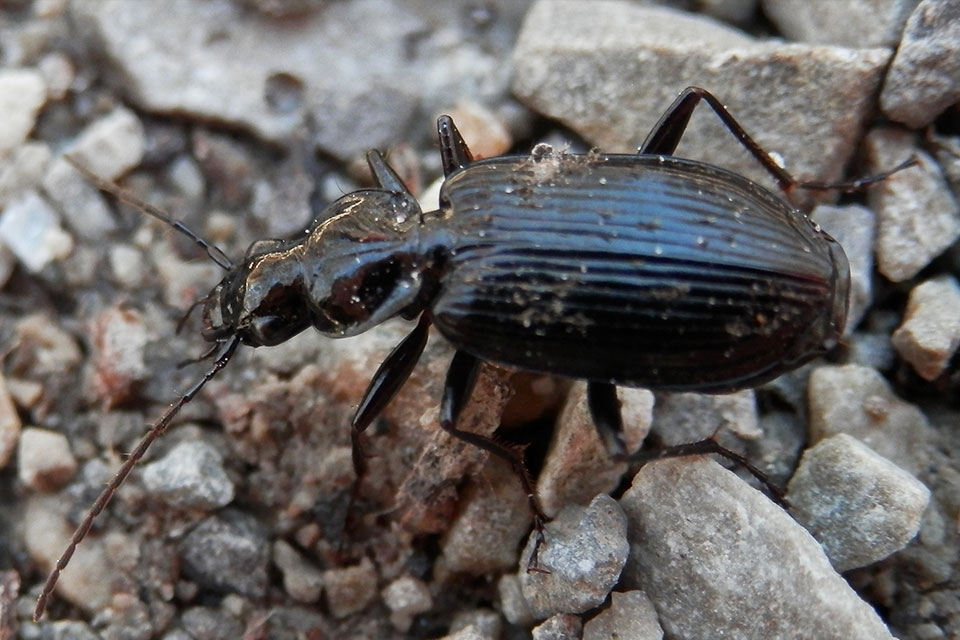
Predaceous Ground Beetle
(Carabidae) – Lively, mostly nocturnal, “eating machines,” tigers of the insect world. They may be easily confused with the slow moving darkling beetle or “iron-clads.”
Ladybird Beetles, or Ladybugs
(Coccinellidae) – All are predaceous in this area. May over-winter in clusters. They are good bio-control agents for aphids!
Rove Beetle
(Staphylinidae) – These are elongated with very stubby elytra (like wings of earwigs). Both larvae and adults are predaceous. Some live in ant and termite nests.
Click Beetle
(Elateridae) – Also elongate; can flip or jump when upside down. Note the spine and pit underside of chest that give them the ability to click.
Scarab Beetle
(Scarabaeidae) — “C” shape larvae (white grubs). Adults have “lamellate” antennae which look like a club with little side-by-side fingers. This variety includes “June bugs”
Leaf Beetle
(Chrysomelidae) — a diverse plant-eating group. Look like elongated ladybird beetles (elm leaf beetle, cucumber beetle).
Weevils
(Curculionidae) – These beetles have a snout or beak, with elbowed antennae on it (not arising on the head, as with other beetles). There are over 60K species of weevils in the world.
Bees, Wasps, Ants, and Sawflies
(Hymenoptera “membrane” wing):
The sawflies, bees, wasps and ants have chewing or lapping mouth parts and undergo complete metamorphosis. All members of this group have two pairs of wings which are joined together with tiny hooks (hamuli) as they fly. They may be confused with flies, which have only one pair of wings.
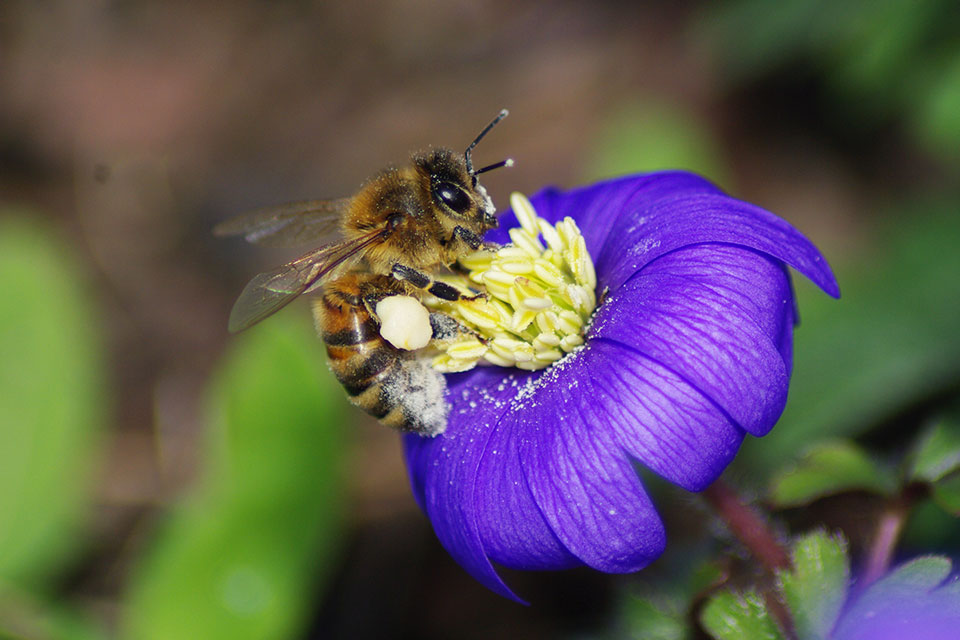
Sawflies & Horntails
These are a large group of “broad-waisted” wasps where the thorax and abdomen seem like one piece in adults. The larvae look and feed like caterpillars.
Wasps
Includes many social and solitary kinds. Wasps are meat eaters (adult & larvae) and have simple body hairs. Examples are “mud-daubers”, “paper-wasps,” “yellow jackets,” “velvet ants,” and parasitic wasps.
Bees
All bees have hairs which look “fuzzy” because of tiny side branches that hold pollen, the source of protein for their young. Examples of bees in our area are honey bees, bumble bees and carpenter bees. The latter look like bumble bees, but lack color bands on their abdomens. They mine old wood for nest sites. Thank honey bees for cross pollinating over 90% of the crops we eat!
Ants
All ants have “elbowed antennae” and a narrow constriction between the thorax and abdomen called a pediole. There are 2500+ species of ants and all have well-developed social lives. Our largest ant, the carpenter ant, mine wood for their tunnels and nests, not for food.
True Flies
(Diptera “two wings”):
The flies, another huge group of higher insects, are identified by having only one pair of wings. Flies are extremely important in the food chain, which is often overlooked when we think of them as medical and agricultural problems.
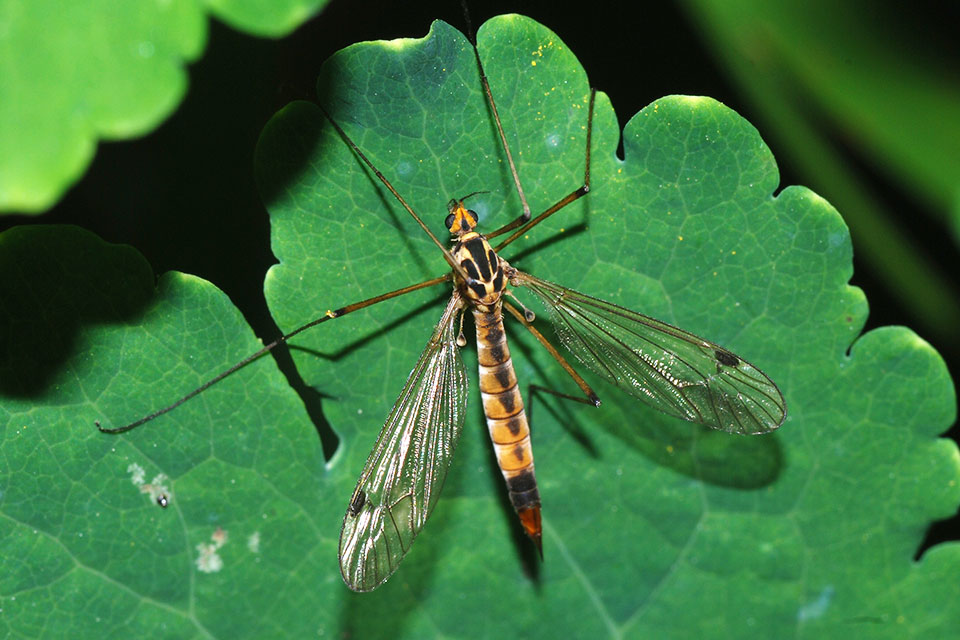
Crane Flies
Their larvae live in moist areas. Adults look like flying daddy-long-legs, or giant mosquitoes (can also be confused with scorpionflies). Adults do not eat, instead living off of fat left over from their larval stage. They are short lived as adults.
Mosquitoes
They have aquatic larvae. Males generally feed on plant juices, only females take blood; they must have a blood meal before producing eggs. They, of course, are vectors of many human diseases.
Midges
Midges look like mosquitoes, but without stylets or hairs on veins. They have very fuzzy antennae. None suck blood. They are important for the food-chain; in the Arctic, their larvae are an important food for nesting shorebirds.
Horse & Deer Flies
Biting flies with large “rainbow” colored eyes.
Robber Flies
Robber flies have a long tapering abdomen and a notch on top of the head between the eyes. They often sit in ambush of flying insects on the uppermost ends of limbs of down trees.
Hover or Flower Flies
Yes, they often hover as they feed on flower nectar and pollen
Muscoid Flies
Includes several dozen families that look like and include house flies. Also includes stable, blow, bluebottle, flesh and parasitic flies. The parasitic flies have stiff hairs on the upper side of their abdomens.
Butterflies, Moths, and Skippers
(Order Lepidoptera “lepido” = scale, wing)
This is the classic group used to illustrate metamorphosis from egg, caterpillar, pupa, and, like a whole new organism, the adult butterfly. They have gone from chewing mouthparts in immature forms to a coiled tube, the proboscis, in the adult. Adults have 2 pairs of wings that function as one, joined by tabs & hooks. Butterflies have scales on their wings, while moths have hairs.

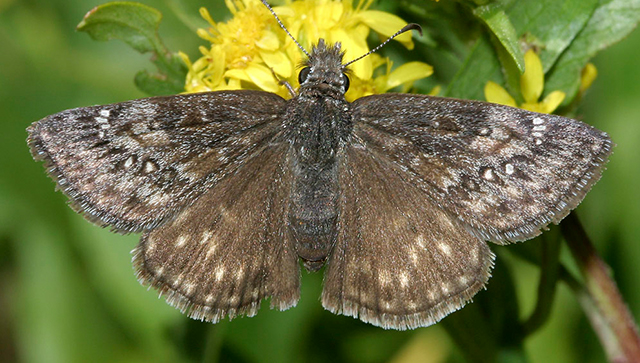
Skippers
Persius Dusky Wing, pictured above.
Robust little guys, with antennae which are hooked at the ends. When their wings are at rest the front wings are vertical and the hind horizonal.
| Skipper Name | Family Hesperiidae | Favorite Caterpillar Food Sources |
| Persius Dusky Wing | Erynnis persius | Lupines, other pea family |
| Two-banded Checkered Skipper | Pyrgus ruralis | Rose family herbs |
| Arctic Skipper (unusual) | Carterocephalus palaemon | |
| Common Branded Skipper | Hesperia comma | Grasses |
| Sonora Skipper (unusual) | Polites sonora | Grasses |
| Woodland Skipper | Ochlodes sylvanoides | Grasses |
Image from Wikimedia under the Creative Commons license.
List from An Atlas of Washington Butterflies, by Hinchliff, 1996; taxonomy from Pyle, 2002
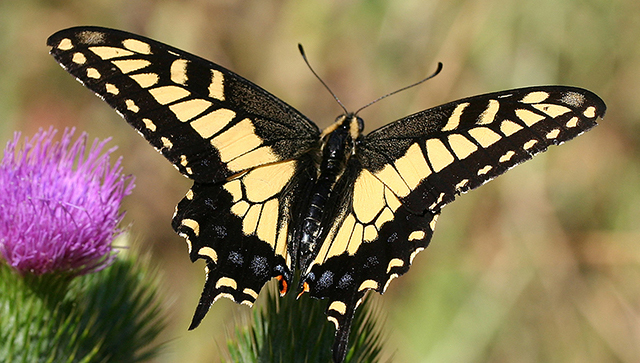
Swallowtails & Parnassians
Anise Swallowtail, pictured above.
Swallowtail larvae are found on plants in the carrot family, and have a forked orange gland that pops out behind the head at will or when you poke it. Adults are generally large yellow and black butterflies with “tails” on their hind wings, which gives them their common name.
| Swallowtail or Parnassian Name | Family Papilionidae | Favorite Caterpillar Food Sources |
| Clodius Parnassian | Parnassius clodius | Bleeding hearts |
| Mountain Parnassian | Parnassius smintheus | Sedum (stonecrops) |
| Anise Swallowtail | Papilio zelicaon | Anise, fennel, parsnip family |
| Western Tiger Swallowtail | Papilio rutulus | Broadleaf trees: maples, willows, etc. |
| Pale Tiger Swallowtail | Papilio eurymedon | Alder, ocean spray, serviceberry |
Image from Wikimedia under the Creative Commons license.
List from An Atlas of Washington Butterflies, by Hinchliff, 1996; taxonomy from Pyle, 2002
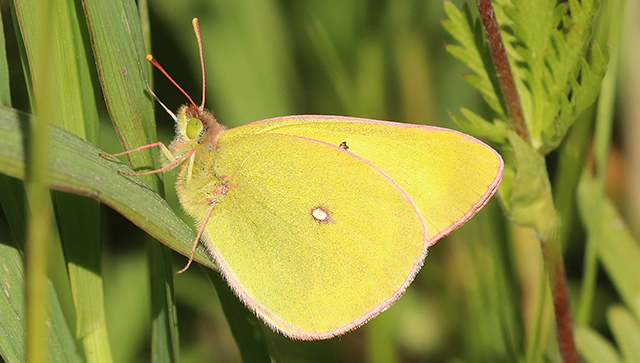
Whites, Marbles & Sulphurs
Western Sulphur, pictured above.
Includes European Cabbage White, butterfly, a bad pest for cabbage and related plants. Its was introduced accidentally near Montreal, Canada in the 1860s. The larvae are bright green.
| White, Marble, or Sulphur Name | Family Pieridae | Favorite Caterpillar Food Sources |
| Pine White | Neophsia menapia | Pines, Douglas fir, other firs |
| Spring White (mountains) | Pontia sisymbrii | Mustard family |
| Western White (unusual) | Pontia occidentalis | Rock cress, peppergrass, mustards |
| Margined White | Pieris marginalis | Mustard family |
| Cabbage White | Pieris rapae | Mustard family |
| Sara Orange Tip | Anthocharis sara | Mustard family |
| Clouded Sulphur (unusual) | Colias philodice | Clovers |
| Western Sulphur | Colias occidentalis | Clovers, peas, vetch, alfalfa |
Image from Wikimedia under the Creative Commons license.
List from An Atlas of Washington Butterflies, by Hinchliff, 1996; taxonomy from Pyle, 2002
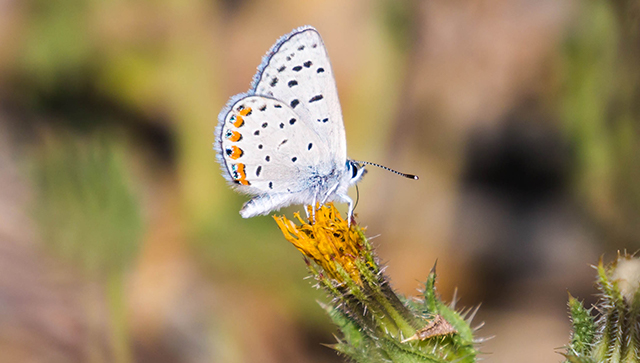
Coppers, Hairstreaks & Blues
Acmon Blue, pictured above.
Small butterflies. Their names describe their colors.
| Copper, Hairstreak, or Blue Name | Family Lycaenidae | Favorite Caterpillar Food Sources |
| Purplish Copper | Lycaena helloides | Docks, knotweeds |
| Lilac-bordered Copper (unusual) | Lycaena nivalis | Knotweeds |
| Mariposa Copper/Makah Copper | Lycaena mariposa | Heath family, bog cranberries |
| Sylvan Hairstreak (unusual) | Satyrium sylvinum | Willows |
| Cedar Hairstreak (unusual) | Mitoura grynea | Cedars, junipers |
| W. Brown Elfin (unusual) | Incisalia augustinus | Heath family, rose family, sages |
| Moss Elfin | Incisalia mossii | Sedum (stonecrops) |
| Gray Hairstreak (unusual) | Strymon melinus | Pea and mallow families |
| W. Tailed Blue | Everes amyntula | Pea family |
| Spring Azure | Celastrina argiolus | Dogwoods, many shrubs |
| Silvery Blue | Glaucopsyche lygdamus | Pea family, lupines |
| Northern Blue | Lycaeides idas | Heath and pea families |
| Greenish Blue | Plebejus saepiolus | Clovers |
| Boisduval’s Blue | Icaricia icariodes | Lupines |
| Acmon Blue | Icaricia acmon | Buckwheats, lupins, vetch |
| Arctic Blue | Agriades podarce | Saxifrages, peas, heats & others |
Image from Wikimedia under the Creative Commons license.
List from An Atlas of Washington Butterflies, by Hinchliff, 1996; taxonomy from Pyle, 2002
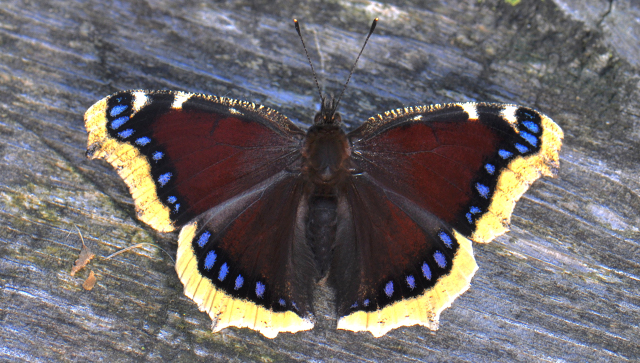
Brush-footed Butterflies
Mourning Cloak, pictured above.
Checkerspots, ladies, buckeyes, admirals, viceroys. They have only 2 pair of legs as adults (the hind pair are very reduced). All are medium-sized, often with orange markings. Larvae usually bear branching spines on their tops and sides. They are found on willows.
| Brush-footed Butterfly Name | Family Nymphalidae | Favorite Caterpillar Food Sources |
| Great Spangled Fritillary | Speyeria cybele | Violets |
| Zerene Fritillary | Speyeria zerene | Violets |
| Hydaspe Fritillary | Speyeria hydaspe | Violets |
| Western Meadow Fritillary | Boloria epithore | Violets |
| Arctic Fritillary | Boloria chariclea | Willows, violets |
| Field Crescent | Phyciodes pulchellus | Asters |
| Mylitta Crescent | Phyciodes mylitta | Thistles |
| Chalcedona Checkerspot | Euphydryas chalcedona | Snowberry, mullein, penstemon |
| Edith’s Checkerspot | Euphydryas editha | Snapdragon family |
| Satyr Anglewing | Polygonia satyrus | Stinging nettle, willows |
| Green Comma (Faun Anglewing) | Polygonia faunus | Willows, alders, rhododendron |
| Hoary Comma (Zephyr Anglewing) | Polygonia gracilis | Huckleberry, currants |
| Oreas Anglewing (rare) | Polygonia oreas | Currants |
| California Tortoiseshell (unusual) | Nymphalis californica carioides | Ceanothus |
| Mourning Cloak | Nymphalis antiopa | Willows, alders, maples, others |
| Milbert’s Tortoiseshell | Nymphalis milberti | Stinging nettle |
| Painted Lady | Vanessa cardui | Thistles, mallows, others |
| West Coast Lady (unusual) | Vanessa annabella | Mallows, nettles |
| Red Admiral | Vanessa atalanta | Stinging nettle, other nettles |
| Lorquin’s Admiral | Limenitis lorquini | Willows, cottonwood, other shrubs |
| Common Wood Nymph (Large Wood Nymph) | Cercyonis pegala | Grasses |
| Vidler’s Alpine | Erebia yidleri | Grasses, sedges |
| Chryxus Arctic | Oeneis Chryxus | Grasses |
Image from Wikimedia under the Creative Commons license.
List from An Atlas of Washington Butterflies, by Hinchliff, 1996; taxonomy from Pyle, 2002
Four Dungeness habitats in which to find insects:
1. Under Soil Beneath Trees
The top layer of whole and decaying leaves offers a rich habitat for small insects and insect relatives. Examine this material closely by spreading it on a sheet and turning it back and forth. The top soil beneath harbors insects even harder to find, but still very important.
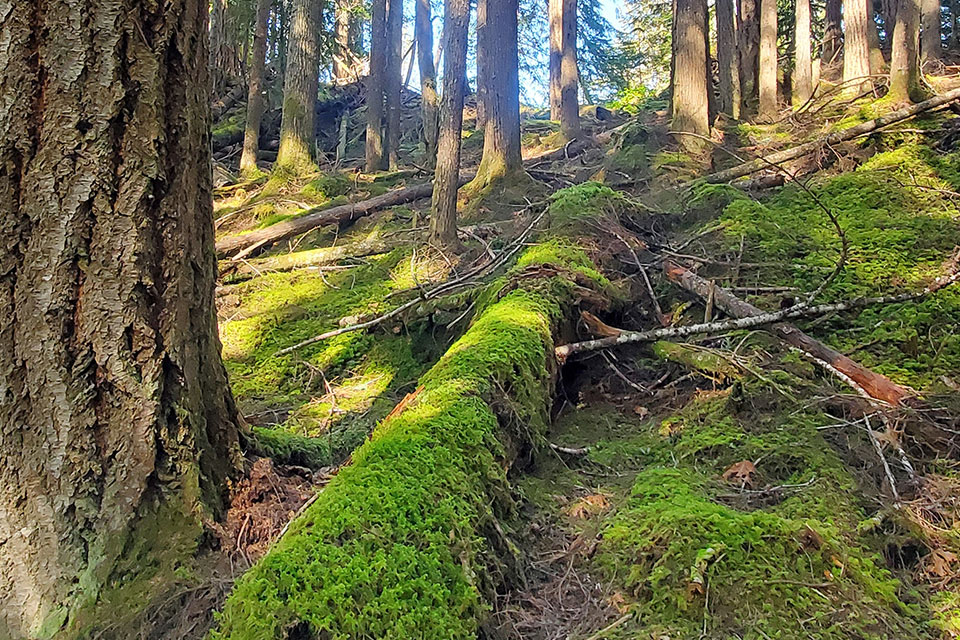
2. Gravel and Sand Bars
Small insects in these habitats are camouflaged, often color-coded to the substrate, with large eyes. Many are nocturnal. Look under larger rocks and chunks of wood (Replace these! It’s their home!). Near the stream, splash water on the bank and watch predatory ground beetles scurry about.
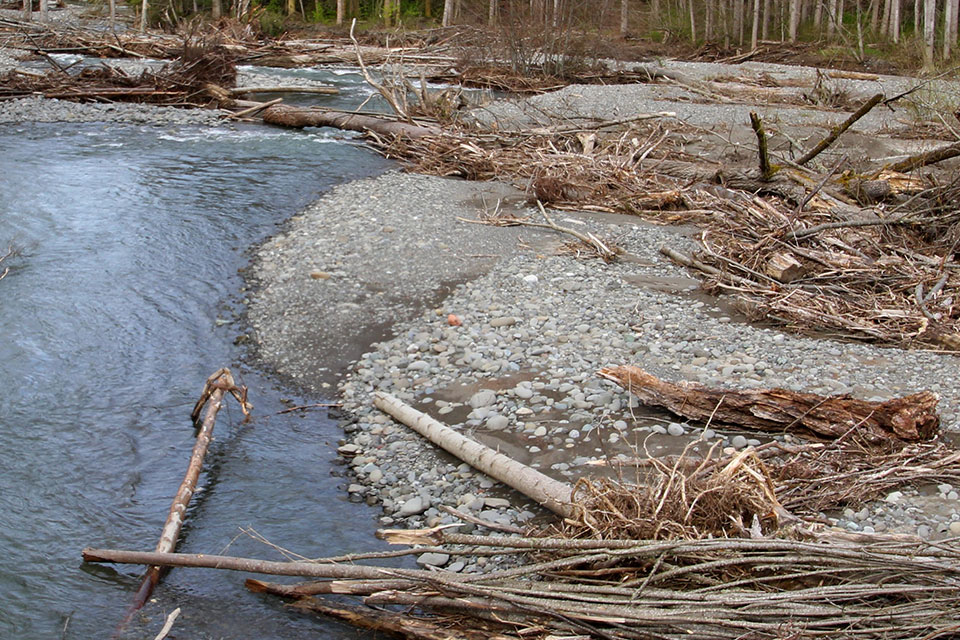
3. Attached to Leaves
Sweep with a net from the undersides of leaves to check for insects in trees. In open sun, stop and observe, seeing how many insects you can see before sweeping with net. Check flower heads. Willows are good host plants for aphids, leaf hoppers, scale insects, galls, flies, and wasps.
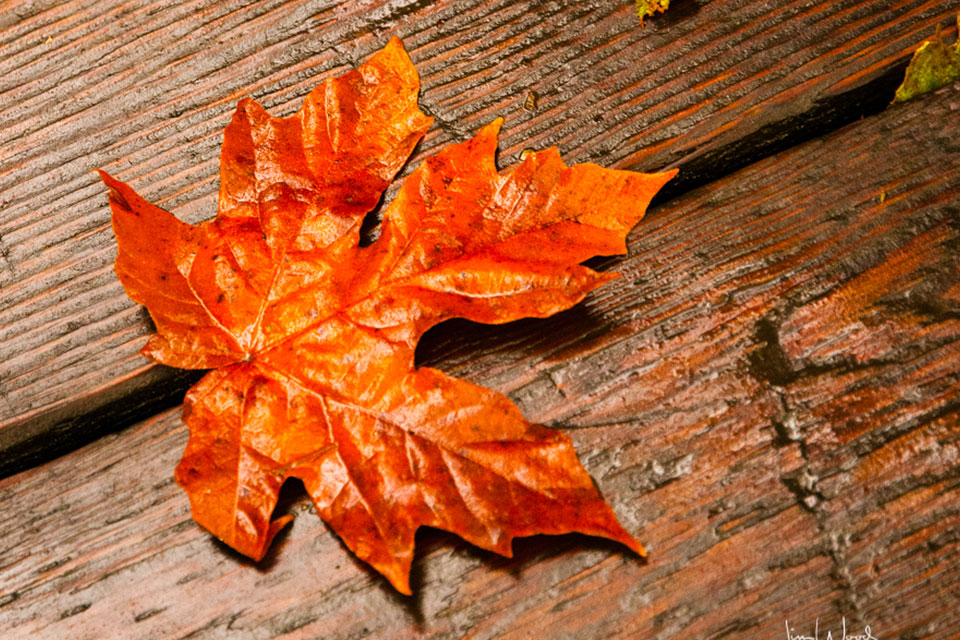
4. Under Rocks in the River and Side Channels
Several types of insects specialize in freshwater habitats, such as stoneflies, mayflies, and caddisflies. They may be predators, scavengers, or algae scrapers. Carefully look under rocks in the river and side channels for these.
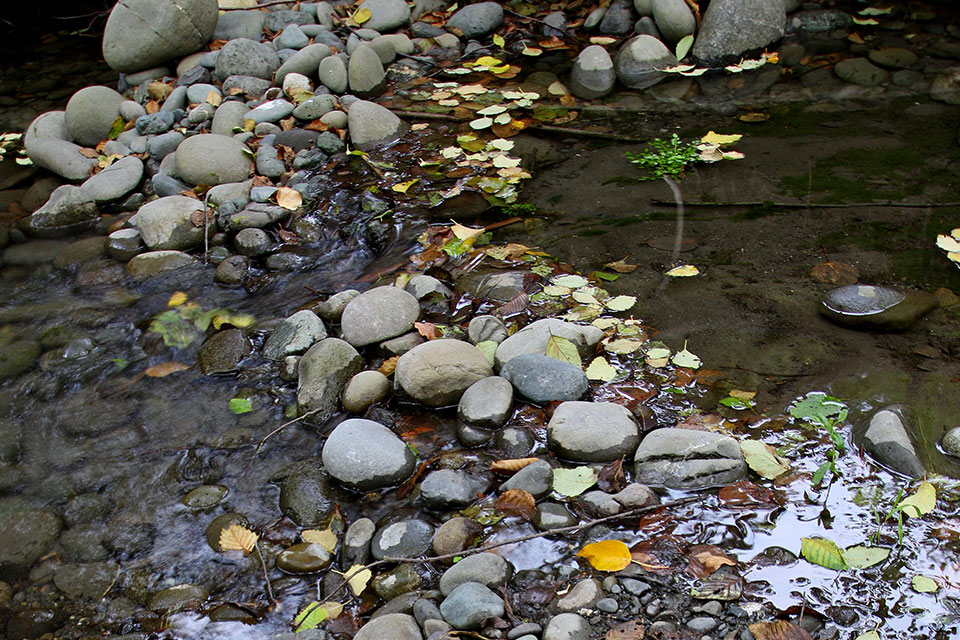
This just touches on the many insects you could see in Railroad Bridge Park. Strike out on your own to identify the other, equally fascinating, insects in the park!

